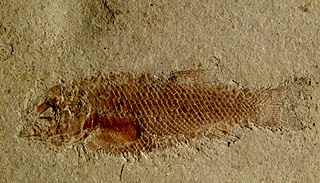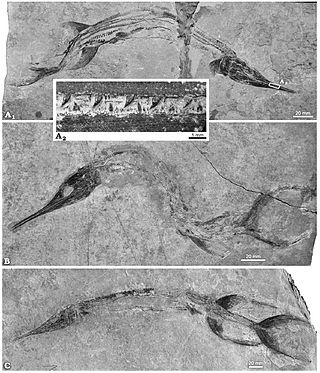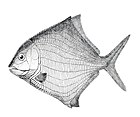
Saurichthys is an extinct genus of predatory ray-finned fish from the Triassic Period. It is the type genus of the family Saurichthyidae, and the most speciose and longest lasting genus in the family. This family also includes the Permian Eosaurichthys (China) and the Jurassic Saurorhynchus from Europe and North America, though it may be more appropriate to treat these as subgenera of Saurichthys, due to the genus Saurichthys otherwise being paraphyletic.

Perleidus is an extinct genus of ray-finned fish from the Triassic period. Fossils have been found in the Middle Triassic of Italy, Switzerland, and China. The inclusion of Early Triassic species in the genus Perleidus was questioned.

Cene is a comune (municipality) in the Province of Bergamo in the Italian region of Lombardy, located about 60 kilometres (37 mi) northeast of Milan and about 15 kilometres (9 mi) northeast of Bergamo.

Birgeria is a genus of carnivorous marine ray-finned fish from the Triassic period. Birgeria had a global distribution, with fossil known from Madagascar, Spitsbergen, Germany, Switzerland, Italy, Slovenia, China, Russia, Canada and Nevada, United States. The oldest fossils are from Griesbachian aged beds of the Wordie Creek Formation of East Greenland. Birgeria existed throughout the entire Triassic period, from the very beginning just after the Permian-Triassic mass extinction, up to the very end with its extinction during the Triassic-Jurassic mass extinction.

Apateodus is a genus of prehistoric marine ray-finned fish which was described by Woodward in 1901. It was a relative of modern lizardfish and lancetfish in the order Aulopiformes, and one of a number of prominent nektonic aulopiforms of Cretaceous marine ecosystems.

Bobosaurus is an extinct genus of sauropterygian reptile related to plesiosaurs. It is based on the holotype MFSN 27285, a partial skeleton found in Early Carnian-age rocks of the Rio del Lago Formation, northeastern Italy. Bobosaurus was named in 2006 by Fabio M. Dalla Vecchia and the type species is B. forojuliensis. It may be a pistosaurid, or closer to Plesiosauria. A recent cladistic analysis found it to be a pistosaur. It was relatively large animal, with more than 3 m (9.8 ft) in length.

Heptanema is an extinct genus of prehistoric coelacanth from the Middle Triassic (Ladinian) of northern Italy and southern Switzerland.

Acentrophorus is an extinct genus of prehistoric freshwater and marine ray-finned fish from the Roadian to the Wuchiapingian of England, Germany (Kupferschiefer), Italy and Russia. There may also be a Triassic occurrence in Australia.

Colobodus is an extinct genus of marine Triassic ray-finned fish of the family Colobodontidae and order Perleidiformes. Fossils have been found in Europe and China, encompassing the former Tethys Ocean. It could reach body lengths of about 70 cm.

Dipteronotus is an extinct genus of marine stem-neopterygian ray-finned fish that existed during the Middle and Late Triassic epochs in what is now Europe and Morocco. As a typical feature, it had several ridge scales in front of its dorsal fin that created a spine-like structure.

Saurorhynchus is an extinct genus of carnivorous bony fish that lived during the Early and Middle Jurassic epochs. Fossils have been found in Europe and North America (Canada). It is commonly found in pelagic and lagoonal deposits, but mostly marine. Largest specimens can grow up to 1.9 metres (6.2 ft).

Sinosaurichthys is an extinct genus of saurichthyid ray-finned fish, which existed in south-western China during the Middle Triassic. Fossils have been found in the Upper Member of the Guanling Formation of two localities: Yangjuan of Panxian County, Guizhou Province, and Dawazi of Luoping, Yunnan Province, China.

Saurichthyiformes is an extinct order of ray-finned fish which existed in Asia, Africa, Australia, Europe and North America, during the late Permian to early Middle Jurassic. Saurichthyiiformes comprise two families, Saurichthyidae and Yelangichthyidae. Yelangichthyidae is monotypic, containing only the genus Yelangichthys. The gar or needlefish-like Saurichthyidae is primarily known from the genus Saurichthys. Additionally, the subgenera SaurorhynchusCostasaurichthys, Eosaurichthys, Lepidosaurichthys, and Sinosaurichthys are frequently used to group species, and are sometimes considered separate genera. Species are known from both marine end freshwater deposits. They had their highest diversity during the Early and Middle Triassic. Their phylogenetic position is uncertain, while they have often been considered members of Chondrostei, and thus related to living sturgeons and paddlefish, phylogenetic analysis of well-preserved remains has considered this relationship equivocal. They may actually belong to the stem-group of Actinopterygii, and thus not closely related to any living group of ray-finned fish.
The Wordie Creek Formation is an uppermost Permian and Lower Triassic geologic formation in Greenland, outcrops of which are located in Northeast Greenland National Park. In 2017, it was suggested to be raised to group status, as the Wordie Creek Group.
This list of fossil fishes described in 2015 is a list of new taxa of jawless vertebrates, placoderms, acanthodians, fossil cartilaginous fishes, bony fishes and other fishes of every kind that have been described during the year 2015, as well as other significant discoveries and events related to paleontology of fishes that occurred in the year 2015. The list only includes taxa at the level of genus or species.

Bergamodactylus is a putative genus of basal pterosaur which lived during the Late Triassic in the area of present-day Bergamo province in Italy. Its only species is Bergamodactylus wildi. It was named in 2015 based on a pterosaur specimen which had previously been regarded as a juvenile Eudimorphodon or as identical to Carniadactylus. Some Triassic pterosaur specialists consider the distinguishing features of Bergamodactylus to be invalid or insufficient to distinguish it from Carniadactylus, and thus retain the specimen in that genus.
Paleontology or palaeontology is the study of prehistoric life forms on Earth through the examination of plant and animal fossils. This includes the study of body fossils, tracks (ichnites), burrows, cast-off parts, fossilised feces (coprolites), palynomorphs and chemical residues. Because humans have encountered fossils for millennia, paleontology has a long history both before and after becoming formalized as a science. This article records significant discoveries and events related to paleontology that occurred or were published in the year 2019.

Teffichthys is an extinct genus of ray-finned fish from the Early Triassic epoch. Fossils have been found in Madagascar and China, and possibly also in Angola, Canada, Greenland, and Svalbard.

Colobodontidae is an extinct family of marine stem-neopterygian fish known from the Middle to Late Triassic of Asia and Europe. As currently defined, it contains three genera: Colobodus, Crenilepis and Feroxichthys. The colobodontids were medium-sized, somewhat deep-bodied fishes with a durophagous diet. Like many other stem-neopterygians, they have traditionally been placed in the order Perleidiformes, which is now thought to be paraphyletic.

The San Salvatore Dolomite, sometimes known as the Salvatore Dolomite or San Salvatore Formation, is a Middle Triassic geological formation in Switzerland and Italy. The primarily lithology is micritic dolomite with a high proportion of algal mounds (stromatolites). It corresponds to a thick warm-water carbonate platform on the northern edge of an island in what is now the Po Plain. This formation and its local equivalents are common in the hills around Lake Maggiore, Varese, and Lugano, preserving fossils of marine invertebrates such as ammonoids, gastropods, and bivalves. At its southernmost extent on Monte San Giorgio, only the lower part of the San Salvatore Dolomite is preserved. The middle and upper parts are replaced by the Besano Formation, San Giorgio Dolomite, and Meride Limestone, which were deposited in a deeper and more anoxic basin between carbonate platforms.
























